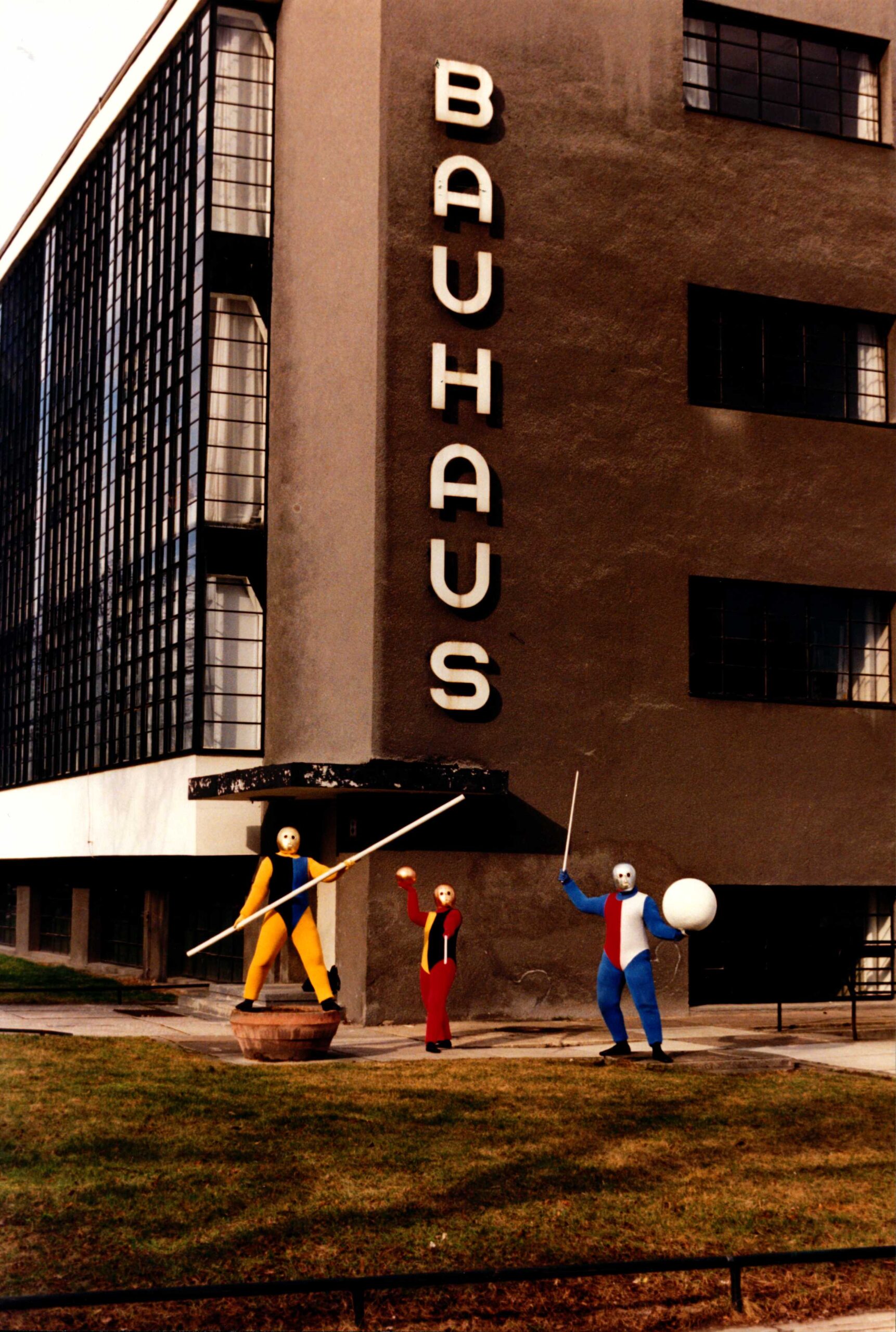
Reconstructed and Directed by Debra McCall
“This revival has been, justly, highly praised…Both as a tour de force of research and as a demonstration of the continuing relevance of the master innovative artists of Modernism.
Artforum
…We are in debt to Debra McCall and everybody else connected with the performance.”
The Bauhaus was a school in which arts, crafts, and technology united to create the “total work of art,” or Gesamtkunstwerk, for the New Architecture of the Weimar Republic. The brainchild of Walter Gropius, the Bauhaus was founded in 1919, the same year as the Weimar Republic. Gropius envisioned an architecture that would fuse new materials and the technology of mass production with beauty and functionality. Inspired by the Bauhütten of the Middle Ages—huts housing the medieval guilds that surrounded the cathedrals under construction—Gropius envisioned a school with workshops taught by both artists and craftspersons or technicians.
To achieve his aim, Gropius devised an experimental curriculum in which students spent their first year in the Preliminary Course, exploring materials in depth and being challenged to question preconceived notions of what art is and how it is to be created. After their first year, students chose a workshop—mural and form (sculpture), painting, metal, weaving, woodworking, stained glass, ceramics, typography and printing—in which they immersed themselves with the same experimental fervor to create new design.
 One of the more successful Bauhaus workshops embodying Gropius’s concerns for uniformity of elements and standardization through abstraction was the Stage Workshop led by Oskar Schlemmer. Der bau, creative construction, drove Schlemmer and the Stage Workshop to pioneer new abstract forms of performance which would become precursors of postmodern dance and performance art. The Stage Workshop also served as the catalyst for such Bauhaus social happenings as the famous Metallic Party.
One of the more successful Bauhaus workshops embodying Gropius’s concerns for uniformity of elements and standardization through abstraction was the Stage Workshop led by Oskar Schlemmer. Der bau, creative construction, drove Schlemmer and the Stage Workshop to pioneer new abstract forms of performance which would become precursors of postmodern dance and performance art. The Stage Workshop also served as the catalyst for such Bauhaus social happenings as the famous Metallic Party.
Inspired by the new cubical stage space Gropius designed for the 1926 Dessau Bauhaus, Schlemmer delivered a series of lecture dances between 1927-29. Preoccupied with simple gesture–walking, sitting, jumping —and influenced by Heinrich Kleist’s widely read essay on the marionette, Schlemmer aimed to create figures that would symbolize the new technology’s potential, but whose human element would supersede the mechanical. In fact, standardizing and unifying the human figure through padded costumes and masks exaggerated their human idiosyncrasies. In Raumtanz (Space Dance), each dancer is assigned a primary color and a tempo to symbolize a psychological temperament. In both Formentanz (Form Dance) and Reifentanz (Hoop Dance), Schlemmer investigates the impact of geometric props or forms on the marionette figure. Metalltanz (Metal Dance) harkens back to the ambience of the medieval Bauhütten, while the nonsensical abstract conversation and gestures in Gestentanz (Gesture Dance) present ironic commentary on social conventions of the day. Baukastenspiel (Block Play) is a parody of competition amongst Bauhaus architects ending with a collaboration around a “cathedral,” and Kulissentanz (dance of the Stage Wings) portrays a whodunit mystery. By extending the inherent anatomical proportion of the human figure via twelve poles attached to limbs and torso in Stäbetanz (Stick or Pole Dance), the dancer engages the geometry of abstract space to create a dance of the Golden Mean or Golden Section.
Debra McCall discovered Schlemmer’s original notes and sketches during a 1980 research trip to Germany. After a year of translation and reconstruction with the assistance of the last remaining performer from the Bauhaus Stage Workshop, Andreas Weininger, and with the support of Mrs. Ise Gropius, the Bauhaus Dances premiered at The Kitchen, New York in 1982. With the addition of more reconstructions, a second premiere occurred at New York’s Solomon R. Guggenheim Museum in conjunction with the exhibition, “Kandinsky: Russian and Bauhaus Years 1915-1933.” Critical acclaim and sold-out houses led to tours of major museums and venues in the US, Europe, and Japan, including the first International Biennale de la Dance in Lyon, France; Artisssima 17 Torino, Italy; and a return to the original Dessau Bauhaus stage in 1994.
The Nazis forced the closure of the Dessau Bauhaus in 1932, but its design influence is felt to this day. Likewise, the avant-garde legacy of Schlemmer and his Stage Workshop students would eventually influence the theory and work of John Cage and Merce Cunningham who studied with Bauhauslers Josef Albers (Preliminary Course Master) and Anni Albers (Weaving Workshop Master) as well as Xanti Schawinsky (Stage Workshop) at the experimental Black Mountain College in North Carolina. In turn, Cage and Cunningham’s experiments in chance composition and indeterminacy later transmitted to dancers via the composition class of Robert Ellis Dunn, giving birth to postmodern dance as the Judson Dance Theater and the seminal Grand Union. Other performance artists influenced by Schlemmer’s theater and supportive of these reconstructions included Meredith Monk, Robert Wilson, Laurie Anderson, and David Byrne.
A film of the reconstructions, directed by Robert Leacock and Debra McCall, premiered at Goethe Institut-New York and was selected by the American Dance Festival for its first Dancing for the Camera: International Festival of Film and Video Dance. It also was included in the Museum of Modern Art “Bauhaus 1919-1933: Workshops for Modernity” and Performa 09. The film and Labanotation for the dances reside at the Library of Congress, Washington DC and the New York Public Library for the Performing Arts at Lincoln Center, New York.
For info, contact: bauhausdances@gmail.com